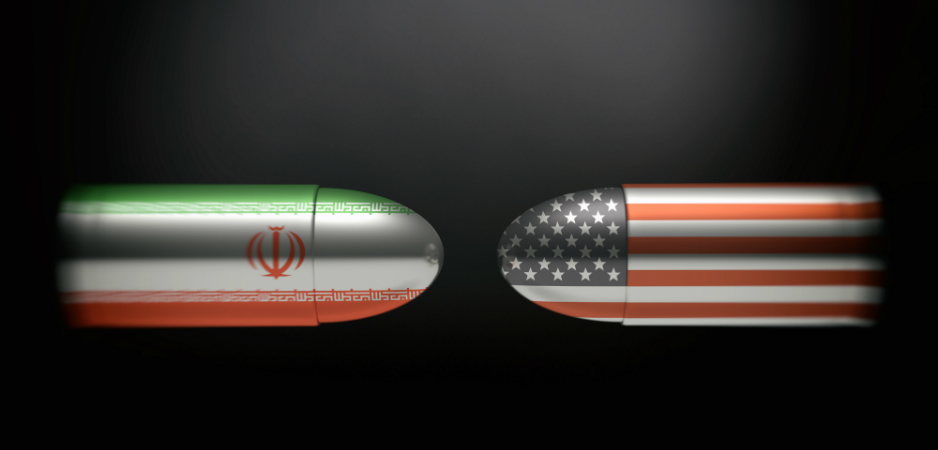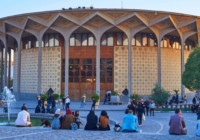By firing missiles over Iraq into Syria, the Iranians delivered a powerful message to Washington at a time when the Trump administration ratchets up its aggression against the Islamic Republic.
On October 1, Iran carried out six missile strikes against Islamic State (IS) targets in Abu Kamal, situated in eastern Syria near the Iraqi border. Iran’s state-owned television showed one missile carrying slogans “Death to America,” “Death to Israel” and “Death to al Saud.” The bold move was officially a retaliation for the deadly attack in Ahvaz, in the Iranian Province of Khuzestan, nine days earlier, which the Iranian leadership blames on IS. In addition to killing “many terrorists” in Abu Kamal, as the Islamic Revolutionary Guard Corps (IRGC) claimed, the missiles also eviscerated stockpiles of the Islamic State’s ammunition and infrastructure. By firing missiles over Iraq into Syria, the Iranians delivered a powerful message to Washington at a time when the Trump administration ratchets up its aggression against the Islamic Republic.
Put simply, the message is that five months after the US withdrew from the Joint Plan of Comprehensive Action (JCPOA), better known as the Iran nuclear deal, Tehran will not change its regional conduct or cave in to pressure from the United States, Israel and certain Arab Gulf states. When it comes to Syria, Iran is set to remain in the country despite the White House’s stated goal to cause a retreat of Iranian forces and proxies. As Tehran begins conducting a more muscular and “offensive” approach in the region following America’s JCPOA decision, hardline elements within the Iranian regime — chiefly within the IRGC, which carried out the October 1 missile strikes — are being empowered.
Also, the International Court of Justice’s (ICJ) October 3 ruling ordered Washington to ensure that its anti-Iran sanctions do not harm humanitarian assistance or civil aviation security. This left officials in Tehran more determined to stay their rigid course even if the ICJ lacks the teeth to enforce the ruling against the United States, which was rejected by US Secretary of State Mike Pompeo.
Other recent instances of Tehran acting confidently against perceived security menaces and asserting a stronger regional clout came on September 8 when Iran killed at least 11 people in long-range missile attacks on the Democratic Party of Iranian Kurdistan’s headquarters in Koya, Iraq, which belongs to the Kurdistan Regional Government. During the previous month, Iranian officials stated that over the previous several months, Iran’s military had transferred several dozen short-range ballistic missiles to Tehran-sponsored Shia militias in Iraq to deter attacks against Iran’s homeland. Depending on from where in Iraq they are placed, these missiles (Zelzal, Fateh-110 and Zolfaqar) can reach both the Saudi and Israeli capitals.
Pressures Within Iran
Such acts, along with the Iranian intelligence ministry’s alleged role in the foiled plot to attack a gathering by the militant Iranian opposition group Mujahedeen-e Khalq in France in June, illustrate how hardliners within the Islamic Republic are demonstrating more will to operate with greater autonomy from the central government, without obtaining permission before acting in the region. As the Iranian economy continues to suffer many ills, from rising unemployment and inflation to excess liquidity, as Washington’s sanctions continue to hurt the country, President Hassan Rouhani appears to find himself in a difficult political situation. That the parliament has summoned Rouhani to provide answers to questions about the country’s economic crises, and with a number of voices calling for his impeachment, the extent to which his centrist government has failed to meet the average Iranian citizen’s expectations about the economic rewards that JCPOA was to bring is clearly highlighted.
As such pressures within Iran intensify, moderate elements within the government struggle to maintain relevance in the country’s political arena. With nationalist sentiments on the rise, moderates have been prompted to align, at least to some degree, with hardliners in support of Tehran’s assertive conduct across the region. For the Iranian leadership, given the Trump administration’s rhetoric and conduct that leave many Iranians fearing a US-orchestrated regime change plot, engaging the White House at this point would be humiliating, particularly given how anti-Iranian Trump’s foreign policy has been since he entered the Oval Office.
Now with the Trump administration calling on Iran to leave Syria, and with a number of Sunni Arab states appearing set on welcoming the regime of Bashar al-Assad back from the cold, the White House, along with its Arab Gulf allies, seems optimistic about plans to accept Assad staying in power for the long term, but only with his regime putting space between itself and Iran. IRGC leaders, however, have declared that Iranian forces will remain in Syria as long as the Damascus regime demands their presence. Given how much Assad owes Iran for his survival, it is difficult to imagine the Syrian regime being in any position to push out the Iranians, who currently wield unprecedented influence over the Baathist order in Damascus.
Further Away from Diplomacy
That Iran’s missiles landed within three miles of US troops in Syria on October 1 shows how grave the risks are of intense friction originating in Washington and Tehran spiraling out of control in the Middle East. With US National Security Adviser John Bolton declaring on September 24 that the US military would remain in Syria “as long as Iranian troops are outside Iranian borders and that includes Iranian proxies and militias,” the 2,000 US troops currently in the country face a likelier possibility of a direct confrontation with Iran’s roughly 10,000 IRGC forces in Syria.
Doubtless, Syria will remain a major point of contention between the US and Iran. Even when bilateral relations were at their warmest after the signing of the Iran nuclear deal in 2015 while Barack Obama was in the White House, Washington and Tehran had serious conflicts of interest in Syria notwithstanding their mutual interest in defeating IS. The JCPOA resolved neither both sides’ opposing stakes in the Syrian crisis, nor any other non-nuclear issue. Yet the nuclear deal afforded both the US and Iran the means to build on some degree of trust to work toward finding common ground on such regional issues such as Syria, along with Iraq, Yemen and Afghanistan.
Without the JCPOA as a foundation, Washington and Tehran are set to address their conflicting interests in Syria on terms that move farther away from diplomatic strategies, raising serious risks of an American-Iranian war that could bring far more devastation and instability to the Middle East than the US-led wars in Afghanistan and Iraq.
The views expressed in this article are the author’s own and do not necessarily reflect Fair Observer’s editorial policy.
Support Fair Observer
We rely on your support for our independence, diversity and quality.
For more than 10 years, Fair Observer has been free, fair and independent. No billionaire owns us, no advertisers control us. We are a reader-supported nonprofit. Unlike many other publications, we keep our content free for readers regardless of where they live or whether they can afford to pay. We have no paywalls and no ads.
In the post-truth era of fake news, echo chambers and filter bubbles, we publish a plurality of perspectives from around the world. Anyone can publish with us, but everyone goes through a rigorous editorial process. So, you get fact-checked, well-reasoned content instead of noise.
We publish 2,500+ voices from 90+ countries. We also conduct education and training programs
on subjects ranging from digital media and journalism to writing and critical thinking. This
doesn’t come cheap. Servers, editors, trainers and web developers cost
money.
Please consider supporting us on a regular basis as a recurring donor or a
sustaining member.
Will you support FO’s journalism?
We rely on your support for our independence, diversity and quality.







